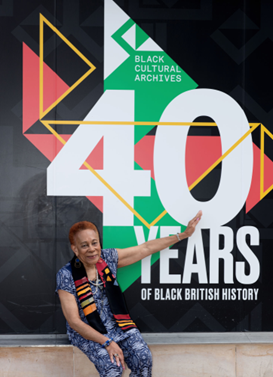Mrs Dawn Hill SRN CBE - Pioneers in the NHS
Chair Black Cultural Archives President Mary Seacole Trust
COMMUNITY DEVELOPMENT LEGACY AWARD

My Father’s sister Aunt Irene Sylvester and her husband uncle Basil Sylvester were my guardians. I am one of 5 siblings. My father died when I was 12 years old and my mother when I was 15. I had taken my senior Cambridge (GCSE) school examination awaiting results and was attending classes, learning to type and to master shorthand. My Uncle had ideas for me to work in the office of his Pimento Oil Factory in Sunset Cove Westmoreland Jamaica. I failed miserably at shorthand and typing so they decided and on the advice of their friend Dr Carnegie to send me to England to study Nursing. I was to go to Leicester General Hospital where he did his medical training internship. I had no input in this decision and aeroplane tickets were booked for me to go to England.
Finally, with much excitement about the clothes packing of my trunk (which I still have) I travelled to England on a Banana boat with 12 passengers coming back from business and holiday in Jamaica. I was classed as a child and under the care of the Captain who knew my uncle.
I was seasick for the entire journey with the occasional visit on deck and eating very little. I arrived in England 5 days before my 17th birthday 25th September 1956.
Travel to London and to Leicester
It was September and despite my wool coat I was freezing. I was met by a male representative from the British Council who accompanied me from the boat at Tilbury docks to the train to Waterloo Station in London. He put me on a train to Leicester with much safety advice and explaining where I was going.
I was to join the Pre-Nursing Cadet Scheme – a new initiative to recruit nurses into the profession. I would be under the care of Miss Gertrude Prior, Matron of Leicester General Hospital 1950 to1967.
At Leicester a car collected me and I was taken to a hostel near the hospital and met other girls on the pre- nursing training programme. They were all very nice to me and that first night and for many nights piled blankets over me. I had never been so cold.
Pre – Nursing Cadet Scheme
This was a 2 year training programme which equipped you with the next level of education, Higher Schools Certificate (A levels ) that was required prior to entering the 3 year State Registered Nurse (SRN) training. I had only one year to do till I was 18 years old. At an RCN annual report meeting Matron Prior reported “the nurses home extension was occupied with full nurse cadet schools and a small and continued increase in nurse recruitment”.
I went to Leicester College of Art and Technology and attached to the Science Department (now DeMontfort University. I studied Anatomy and Physiology, English Literature and Dietetic Cookery.
I had the most wonderful anatomy tutor Dr Crow, a great teacher, who diagnosed my frozen fingers syndrome and was happy for me to sit by the classroom basin warming my fingers back from blue.
Throughout my year at College, I was treated like any other student at the college. I came first in the 4 x100 meters relay at the 23rd Annual Athletics sports day in 1957.
During the first year Cadets did not go on the wards but were given a full induction of the hospital’s departments and facilities and helped with directing visitors at the weekend to the right wards. Cadets also had sessions with the Tutors about their progress.
In the second year we were allocated sessions at weekends on the wards to observe and assist the nurses with assigned tasks e.g bedmaking, cleaning bedpans and other ward duties. We were expert at cleaning at the end of our cadet training. There were report back sessions with the nurse tutors about every 2 months. Finally, we took our college examinations and on the basis of the results you were recommended to start your general nurse training.
SRN Training
We moved to the main Nurses home and fell in with our year group thankfully with some friends from my cadet year. Regimes were very strict with lights out at 10 pm. In the classroom our Tutors Miss Newt and Miss Robson were so strict with no let up on the extensive reading set, hygiene rules and cleaning standards. The skeleton “Jimmy” always present. Yes, we were told of Florence Nightingale, but I never heard about Mary Seacole.
The mantra at the LGH was Semper ad Suprema. My abiding memory of my training and working at LGH is “Sister is Sister, but Matron is the law.”
There were other nurses from the Caribbean in training, they were on the State Enrolled Course (SEN) training programme. I had no idea why this was, and I caused upset when I tried to find out why. I believed that the upset was because Matron was my guardian, and I went to tea at her house on site to report on how I was getting on. I was always sent to represent the Caribbean nurses at civil events and meeting VIPs. My uncle would also send a large barrel from Jamaica at Christmas with bananas and other exotic fruit and Christmas cake. Matron however would ensure that everyone in my year regardless indulged in the goodies.
I loved working in the operating theatres where my knowledge of Anatomy and Physiology served me well. This directed the rest of my nursing career.
I qualified as an SRN in December 1960 and worked as a theatre nurse from 1960 to 1968 in various London hospitals taking time out to do my Midwifery training at the Bearsted Memorial Hospital in 1965. I only completed Part 1 of the training and left with a “Good” certificate. Memorable theatre posts were at the London Chest Hospital, and at the famous Neuro Surgical Hospital Queens Square where I received training and worked with amazing surgeons. I was then recommended to the Wittington Hospital to take charge as Superintendent of the Neuro- surgical theatres in 1968.
I left the Whittington after I lodged a grievance about the grading of my post. The RCN procedures were not in my favour. The 1966 proposals set out in the new Salmon Committee Senior Nurse structure grading system, based on first line Ward sister, middle and top management tiers caused considerable debate which finally replaced Matrons with Divisional Nursing Officers. It was the first time I experienced “a clash with the powers” on how my post should be graded.
My last post as Senior Theatre Sister Neurosurgery was at the Brook General Hospital from which I left to attend the London School of Economics in 1971.
I loved the work I chose to do as a nurse in the NHS. However, I left to study Social Policy & Administration and personnel management as I felt there had to be a better way to manage the staffing and pay grades in hospitals.
My greatest concern now is that the recruitment to the nursing profession and across the allied and support staff to the NHS will suffer as a result of the quite catastrophic effect of COVID -19 on (BME) Caribbean, African, Asian and other ethnic minorities working on the frontline in hospitals and Care Homes. How would they be looked after if working in the NHS? Will they want to join an NHS that has taken the lives of so many of their brothers and sisters, mothers, fathers and grandparents?
It is an honour to be included in this publication. I am pleased to be associated with the Mary Seacole Trust as their President and with the erection of her Statue at St Thomas’ Hospital, Westminster, London. Mary is now rightly recognised for her pioneering work as a nurse and for her great work nursing soldiers in the Crimean war.
Finally, it is my expectation that Black Cultural Archives will one day mount a major exhibition that will educate and celebrate the contribution of the Caribbean and African Nurses in post – colonial Britain.
